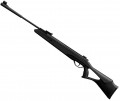Type
The type describes the basic operating principle of the rifle. Nowadays, you can find pneumatics with
a spring-piston operating principle (with a regular or
gas spring), with
pre-pumping (PCP), with pumping before each shot (
multi-compression rifles), with power
from carbon dioxide cartridges and with
an electric drive. Here is a more detailed description of each of these types:
— Spring-piston. As the name suggests, the mechanism of such rifles is based on a spring-loaded piston moving in a cylinder. The weapon is cocked manually (usually by a lever or by breaking the barrel), with the piston being pulled back and fixed, the cylinder being filled with air, and when the trigger is pulled, the piston is released and moves forward under the action of the spring, pushing the air out of the cylinder into the barrel. Rifles of this type are distinguished by their simple and reliable design, low cost, low maintenance, and ease of repair and tuning; they are considered an ideal option for beginner shooters, as well as for fans of entertaining short-range shooting, and there are also airsoft models among them. It is also worth mentioning the excellent repeatability of shots (with each cocking, a strictly defined portion of air enters the cylinder) and insensitivity to he
...at and cold. On the other hand, such rifles require cocking (and most often reloading) before each shot, which can be quite tiring; and the operation of the piston mechanism creates a specific recoil, which negatively affects accuracy and complicates the search filter of optical sights (special optics are required, originally intended for such use). In addition, this type of pneumatics cannot be kept charged for a long time - with prolonged compression, the mainspring loses its properties.
— With a gas spring. In general, the operating principle of this type of rifle is similar to the spring-piston rifles described above. The difference is that instead of a conventional metal spring, they use a sealed reservoir with a special gas, which acts as a spring — compressing when cocked and expanding when fired. This design has a number of advantages over a conventional spring-piston rifle. Firstly, the entire mechanism operates much smoother and quieter, and the recoil is softer, which improves accuracy and simplifies the search filter of optics. Secondly, the gas spring does not change its properties as it wears out, and such a weapon can be stored even in a cocked state. Thirdly, repairs and maintenance for gas springs are required less often and are cheaper (in terms of the number of shots between visits to the workshop). The disadvantages of this type of rifle, in addition to the need to cock the spring before each shot, include a slightly higher cost than classic spring-piston rifles, as well as sensitivity to cold: as the temperature drops, the gas pressure in the spring decreases, which reduces efficiency.
— PCP (pre-pumping). The source of energy in rifles of this type is a built-in reservoir containing air (or another gas) under very high pressure — about 200 or even 300 atmospheres. This reserve is enough for at least several dozen shots, and a compressor, a scuba tank or a special high-pressure pump can be used to fill the reservoir (sometimes such pumps are even supplied in the kit). In general, PCP is considered the most advanced type of pneumatics; it is these rifles that professional hunters and sportsmen use. This is primarily due to the fact that such a design allows for a very high bullet speed, and the recoil is almost imperceptible — all this allows for accurate shooting even at long distances. With a fresh gas, the rifle gives excellent repeatability of shots; however, as the gas is consumed, the initial speed of the bullet decreases, but advanced models may be equipped with a reducer that compensates for this phenomenon (for more details, see "Air supply with a reducer"). PCP pneumatics can be easily made multi-shot and provide very simple and convenient ways of feeding the next bullet into the barrel. The main disadvantage of such rifles is the high price.
— Multi-compression. Another type of rifle with a built-in reservoir; however, unlike the PCPs described above, the reservoir must be pumped up before each shot. For this purpose, the design provides a built-in pump controlled by a lever or other similar device; to pump in a sufficient amount of air, as a rule, you need to make several movements. Such rifles have virtually no recoil, while they are noticeably simpler and cheaper than PCP pneumatics, but inferior to it in power. In addition, pumping up the reservoir before each shot is quite a tedious task; and the volume of air supplied to the reservoir with each filling (and, accordingly, the working pressure in the reservoir) will depend on the number and amplitude of movements made by the pump lever. On the one hand, this allows you to adjust the power directly "on the go": for example, for a short range, where the maximum bullet speed is not required, you can pump the rifle not completely in order to save energy. On the other hand, the actual volume of air and pressure in the reservoir will be slightly different with each reload, even with the same number of lever movements. This has a negative effect on the repeatability of shots. Due to this combination of features, multi-compression models are not very popular these days, and their purpose is mainly recreational shooting.
— Gas cylinder. A type of pneumatics that operates from replaceable gas cylinders, usually liquefied carbon dioxide. Like PCP, such a reservoir allows you to make a lot of shots — even a traditional 12-gram cylinder is usually enough for several dozen; and some models use containers for 88 g of carbon dioxide. At the same time, the rifles themselves are cheaper than PCP, but have less power. It is also worth noting the rather specific characteristics of carbon dioxide as an energy source. On the one hand, it maintains working pressure for quite a long time — it does not decrease as long as liquid carbon dioxide remains in the cylinder. On the other hand, the actual gas pressure depends on the ambient air temperature, and the initial velocity of the bullet in such pneumatics can change significantly even with daily temperature fluctuations. And one of the clear disadvantages of such rifles is that you have to buy not only bullets for them, but also gas.
— AEG (electrically driven). Pneumatics that use an electric motor drive as a source of energy. In terms of the design of the working mechanism, it is similar to a spring-piston one — the basis of this mechanism is a cylinder and a spring-loaded piston. However, in this case, the piston is not pulled back manually, but with the help of the aforementioned electric motor. For the shooter, this means, first of all, that the rifle does not need to be cocked by muscle force — to fire, it is enough to press the trigger, the electric motor will do the rest. In addition, in such pneumatics, an automatic shooting mode can be easily provided (see below). Note that for a number of reasons, this operating principle is practically not found in traditional pneumatics, but it is very popular in airsoft models; such rifles ("drives") often copy real combat weapons.Muzzle velocity
The muzzle velocity provided by the rifle - that is, the speed of the bullet as it exits the barrel.
All other things being equal, a higher bullet speed provides greater range and accuracy, and also simplifies aiming at long distances: the bullet flies along a smoother trajectory and requires fewer adjustments in height, and the influence of side winds decreases with increasing speed. On the other hand, this indicator directly affects the price of the rifle; and in some countries, legal restrictions on the ownership of pneumatic weapons are also related to the muzzle velocity of the bullet.
As for specific values, in the weakest modern rifles the initial speed does not exceed
150 m/s, and in the most powerful it can be
300 - 350 m/s or even
more(remember, the speed of sound is 330 m/s). In general, for recreational shooting at short distances, this parameter is not particularly important, and detailed recommendations for choosing pneumatics for more specific situations can be found in special sources. Let us only note that in AEG electric drives (see “Type”) the initial speed extremely rarely exceeds 150 m/s, but this is done solely for safety reasons: such “weapons” are intended for military-tactical games and initially involve shooting at people, and the high speed would be unsafe for players even with protective equipment.
It is also wor
...th considering that this indicator is not strictly defined. In any type of pneumatic it depends on the weight of the bullet (the lighter the faster); therefore, in the characteristics it is usually customary to indicate a certain average velocity for standard ammunition (usually weighing 0.5 g, in AEG - 0.2 g). In addition, in multi-compression rifles the actual speed of the bullet is determined by the degree of inflation, in gas-cylinder rifles it is determined by the ambient temperature, and in PCP models it is possible to achieve higher speeds than declared by replacing the air with a special gas (for example, helium). Nevertheless, this characteristic makes it possible to evaluate the capabilities of the rifle and compare it with other models, including those that differ in type.Adjustable trigger
The ability to adjust the features of the trigger triggering of the rifle — first of all, the idle (before triggering) stroke of the trigger and the force on the hook. This allows you to optimally adjust the characteristics of the weapon to the personal preferences of everyone: for example, it is usually difficult for beginners to shoot with a tight trigger, but for trained shooters, a too soft hook that “falls through” under the finger may be inconvenient.
Barrel length
The working length of the rifle barrel is from the chamber where the bullet is loaded to the muzzle. The shortest barrels found nowadays have a length
of just over 200 mm(and in some AEGs even
less than this value); the longest reach
500 – 600 mm.
There is a stereotype that the muzzle velocity directly depends on the length of the barrel. In firearms, this is true — but not in pneumatics. Firstly, in such rifles, the initial velocity depends on a number of other indicators — pressure, the quality of the barrel treatment, the efficiency of the valves, etc. on the first 20 – 25 cm of the barrel, then the gas pressure drops noticeably. The exception is PCP rifles, in which the longer barrel really makes it easier to achieve high speeds. However, again, so many additional factors affect the final result that models with the same barrel length can differ markedly in initial speed.
The second common stereotype is that a longer barrel improves accuracy and accuracy. This is true in the context that a longer barrel allows for a greater distance between the front and rear sights, making it easier to aim carefully. Technical accuracy does not depend on the length, but on the quality of the barrel processing.
Summing up all of the above, we can say that the length of the barrel for an air rifle is more of a reference than a really significant paramete
...r, and when choosing, it is better to focus on more "close to life" characteristics — first of all, directly claimed muzzle velocity.
